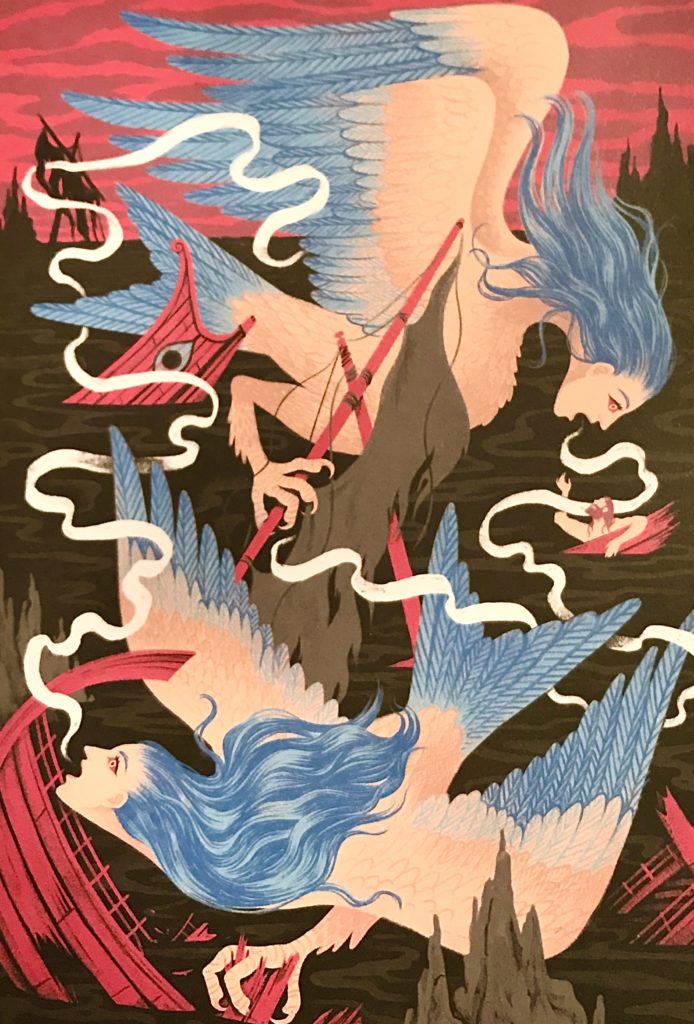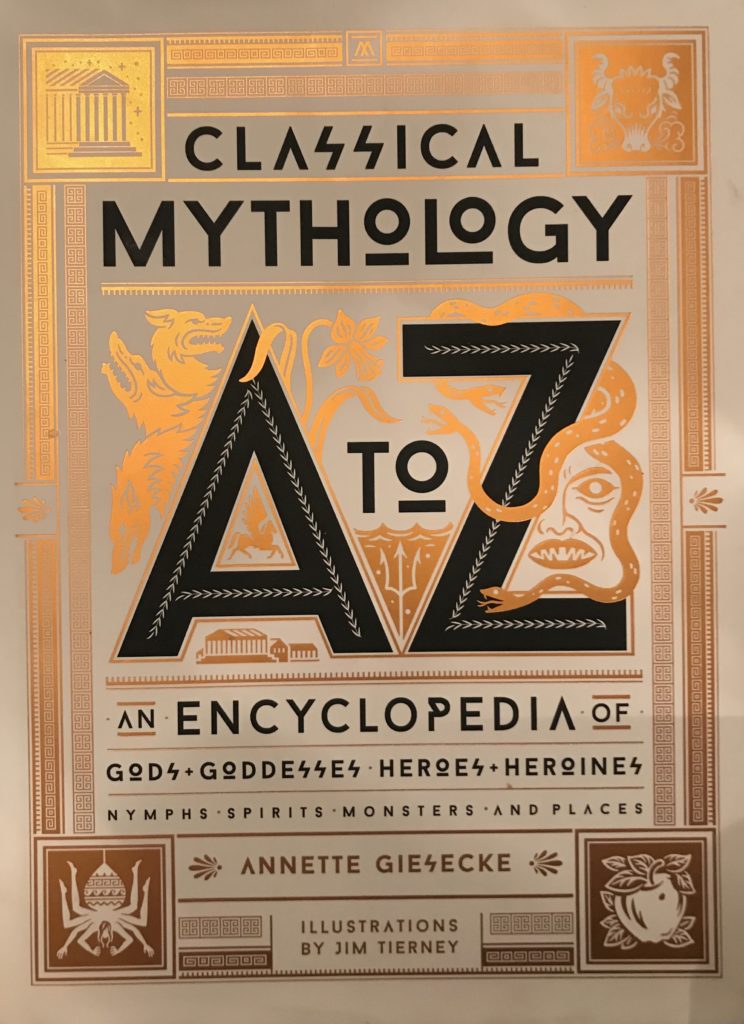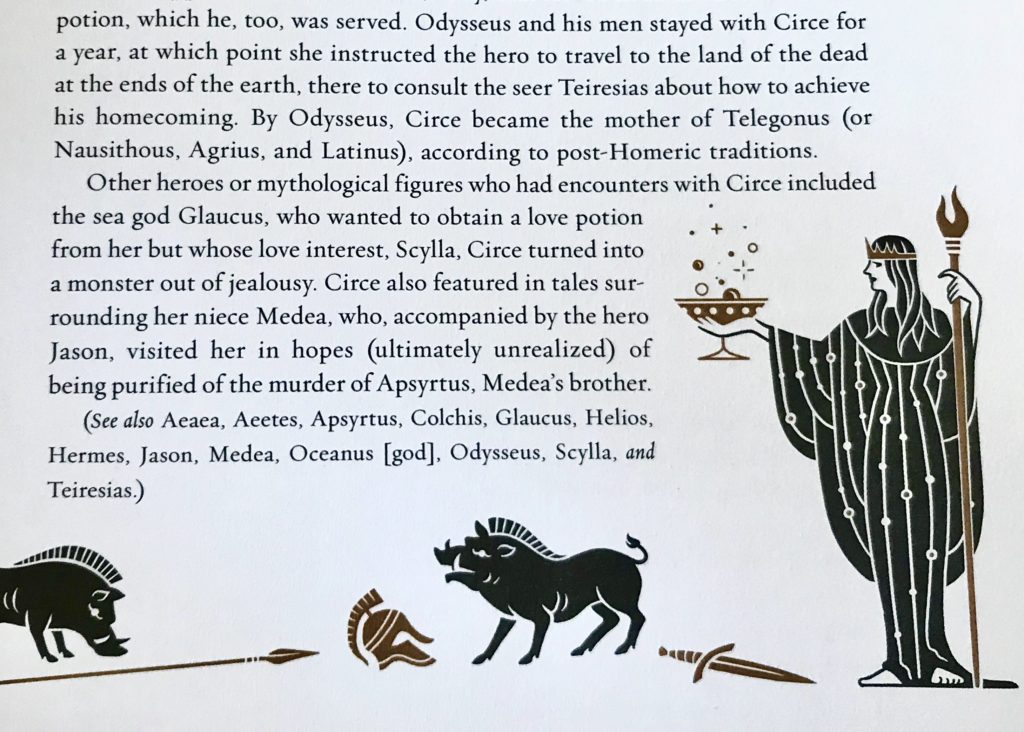
By Patrick Hunt –
Annette Giesecke has recently added a wonderful and indispensable book to the corpus of mythology: Classical Mythology A to Z: An Encyclopedia of Gods, Goddesses, Heroes, Heroines, Nymphs, Spirits, Monsters and Places (Black Dog & Leventhal / Hachette Group, 2020). While “beautiful” isn’t the most important requisite of a book, this carefully-written and imaginative study nonetheless deserves that epithet, not the least for its lucid writing and ability to evoke the Classical World so clearly. But the book also deserves this description for its design and its ample and peerless illustrations by Jim Tierney – strikingly bold and original color plates – and the sheer gemlike quality of its layout where many pages are also decorated with smaller bicolor iconic images. My favorite colored illustration by Tierney (Plate VIII) is near the end of this encyclopedia on p. 298, “The Sirens”, shown above. Tierney also illustrated the iconic 75th Anniversary edition of Edith Hamilton’s landmark Mythology, which is apropos. While not necessarily aimed to replace Edith Hamilton by any means, it will be remembered and admired with the same admiration for as many generations. If I were a youth now, this lavish book – ostensibly for reference – would likely inspire my life to become immersed in Classical mythology just as Hamilton’s enriched my life and that of many others over several generations. Each generation needs a mythology reference book like this, since mythology is immortal and always relevant to successive cultures but nonetheless helpful when language is both contemporary and universal as here.

This meticulously planned book is naturally divided into logical parts, prioritized by the importance of the roles in the myths and frequency of mention in their interrelationships with other persons and events. Part One is Gods, Goddesses, Spirits and Nymphs based on divine parentage and immortality. Part Two is Heroes, Heroines, and Peoples based on mortality. Part Three is Monsters, Prodigies and Hybrid Creatures based on their unusual nature and often negative role in human punishment. Part Four is Places and Landmarks in the ancient landscapes. Few mythological reference works make these needed distinctions so well.
One of my favorite passages is on the story and site of Troy (pp. 354-55) with many cross references to persons and events following; another favorite is the entry for the god Dionysus (pp. 40-42) with many parts of the narrative sharing references to seminal literature, for example, Euripides’ Bacchae. The entry on Aeneas (pp. 120-22) is also a favorite for its terse richness yet as elsewhere, economical with enough detail but never florid. Since the selected stories in Giesecke’s encyclopedia are so historically memorable, the language is appropriately majestic without ever needing embellishment by melodrama or the added commentary of millennia.

Having written many articles and several books either directly on or peripheral to Classical mythology and related art and having illustrated another for the Penguin Group, I am easily compelled to acknowledge this reference book is not only comprehensively well thought out but also well-documented for the ancient writers and mythographers who contributed to the mainstream of mythology, with a Glossary of Ancient Sources in the back matter. The Introduction perfectly lays out the rationale for the book and its own debts to prior literature. While there are no needed footnotes or endnotes, the text is full of embedded references without being distracting or impeding the flow of the crafted prose. Archaeological resources are also up-to-date for religious temples, shrines and holy places as well as confirmed sites important to the narratives. Reading alphabetically as one would expect in encyclopedic format, cross references are frequent at the end of nearly every entry. There is also a useful index in the back matter, often a place to start in researching mythology. Since this reviewer luckily received an advance copy, I’ve already cited this book in a forthcoming (late 2020, early 2021) book on mythology and art. In summary, I most highly recommend this book not only for those interested in mythology in general and libraries but also for undergraduate, graduate and postgraduate classroom use: I will be requiring this indispensable book in a Stanford myth and art course in early 2021.